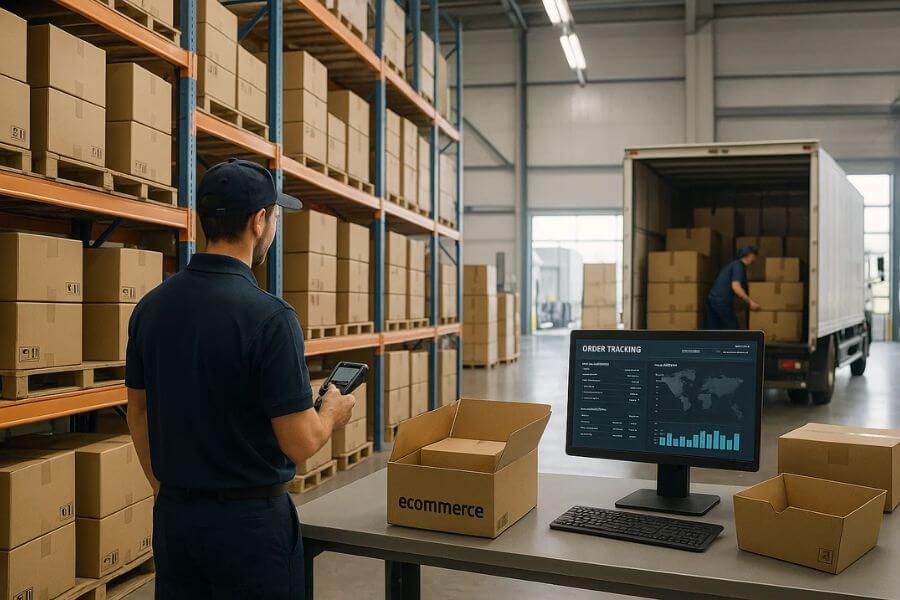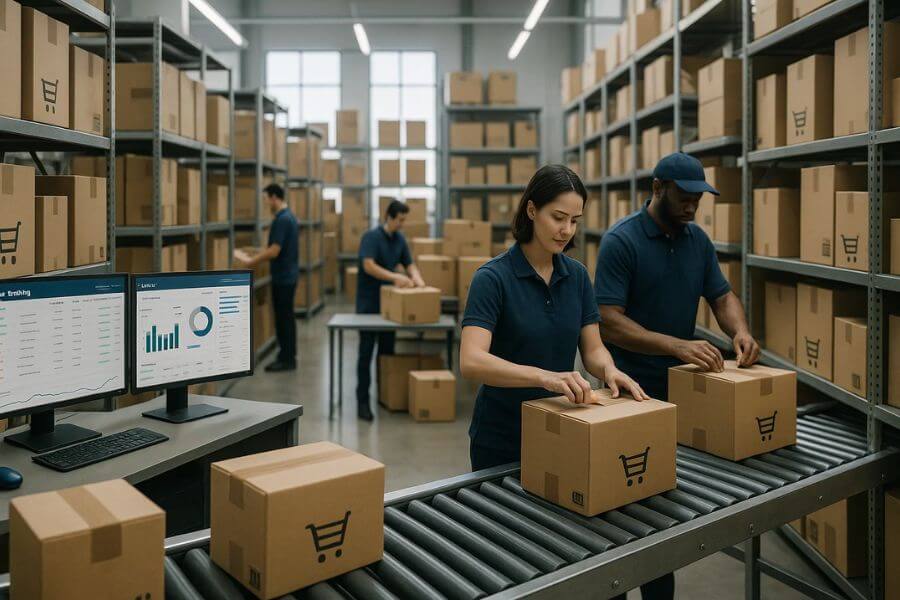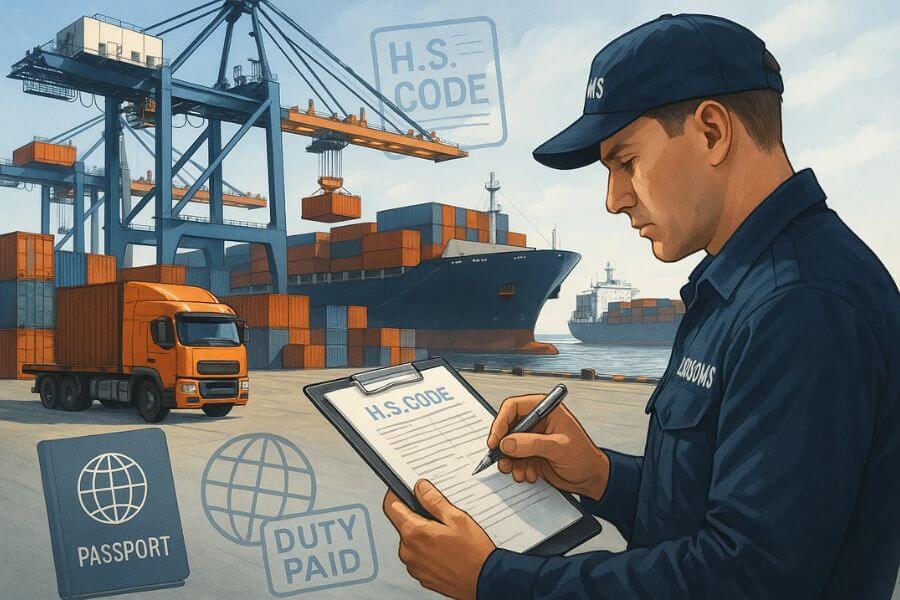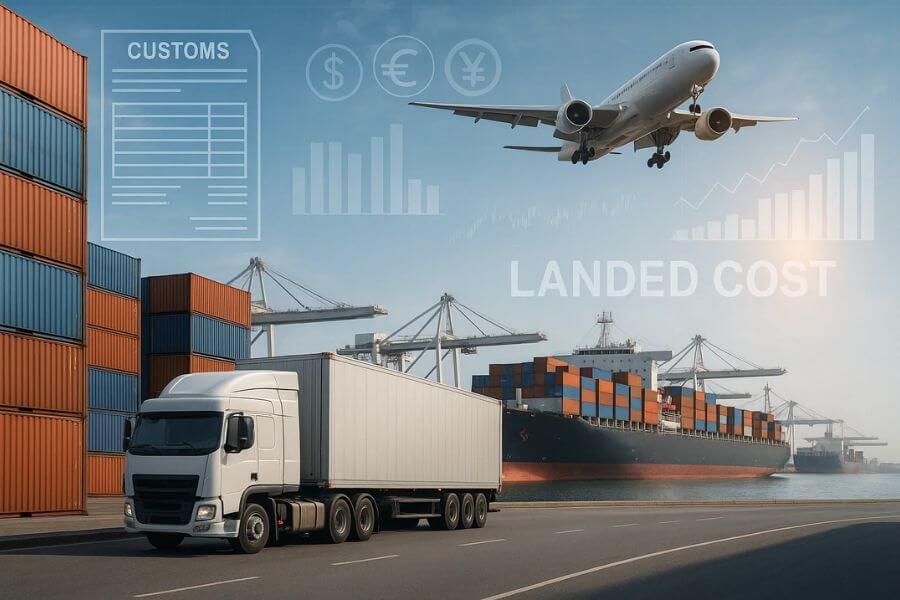In the dynamic world of ecommerce, one-size-fits-all solutions rarely lead to long-term success. This is particularly true when it comes to order fulfillment. As customer expectations rise and business models become increasingly diverse, brands are turning to hybrid fulfillment, a strategic mix of multiple fulfillment methods, to stay competitive, cost-effective, and scalable.
Hybrid fulfillment is a logistics strategy that allows you to combine various fulfillment approaches such as in-house fulfillment, third-party logistics (3PL), and dropshipping. Rather than relying solely on one fulfillment channel, hybrid fulfillment lets you customize your supply chain to fit different products, regions, customer needs, and seasonal demands.
This guide explores hybrid fulfillment from every angle, including its benefits, challenges, implementation strategies, and the technology that powers it.
Why hybrid fulfillment is the future of ecommerce?
Ecommerce success hinges on efficiency, speed, and adaptability. While traditional fulfillment models like fully in-house or completely outsourced logistics have served many businesses well, they often present challenges as companies grow or diversify.
Hybrid fulfillment offers a more adaptable and resilient alternative. Here’s why it’s quickly becoming a go-to model:
Adaptability across sales channels
Selling across multiple platforms like Amazon, Shopify, Etsy, and your own website requires different fulfillment strategies. A hybrid model allows you to route each order through the most effective channel based on origin, destination, and product type.
Reduced operational risks
If your in-house team becomes overwhelmed during peak periods or a 3PL facility experiences delays, having multiple fulfillment options can keep your orders flowing. This redundancy minimizes downtime and protects the customer experience.
Customization and control
Some products may need special packaging, branding, or handling. Others may be better suited for mass shipment via a 3PL or direct delivery from a manufacturer. Hybrid fulfillment gives you the ability to manage each SKU differently without sacrificing consistency.
In an era where customers expect fast, affordable, and personalized service, hybrid fulfillment equips businesses with the tools to deliver on those expectations while remaining lean and cost-effective.
What are the core components of hybrid fulfillment?
At its foundation, hybrid fulfillment brings together three main strategies. Let’s explore each of them in detail and see how they can be integrated effectively.
In-house fulfillment
This involves storing inventory and fulfilling orders directly from your own warehouse or office. It’s often the first step for new ecommerce businesses and remains valuable for high-margin or customizable products.
Advantages:
- Brand control: You dictate how items are picked, packed, and presented.
- Faster handling: Especially for local orders, in-house fulfillment can be the fastest method.
- Customer experience: You can include branded packaging, handwritten notes, or samples.
Disadvantages:
- Limited scalability: Handling fulfillment internally becomes labor- and cost-intensive as order volume grows.
- Capital investment: Managing your own warehouse requires staffing, insurance, utilities, and equipment.
In-house fulfillment works best when product control and customer experience are top priorities or when your brand wants to deliver a “white glove” experience.
Third-party logistics (3PL)
3PL providers store, pick, pack, and ship your products on your behalf. They have multiple warehouse locations and are ideal for expanding quickly without physical overhead.
Advantages:
- Scalability: Effortlessly handle spikes in order volume or expand into new markets.
- Geographic reach: Many 3PLs have fulfillment centers across the country (or globe), allowing for faster shipping.
- Cost efficiency: Lower shipping rates, reduced labor, and optimized logistics routes.
Disadvantages:
- Less control: Branding and packaging options may be limited unless negotiated in advance.
- Integration required: A strong tech stack is necessary to keep operations synced with your online store.
Choosing the right 3PL partner is crucial. Look for providers who offer integrations with your ecommerce platform and have transparent service-level agreements.
Dropshipping
Dropshipping allows you to sell products without holding inventory. When a customer places an order, it’s fulfilled directly by a supplier or manufacturer who ships the product.
Advantages:
- Low overhead: No inventory, warehouse space, or staff required.
- Quick product expansion: You can test new products with minimal risk.
Disadvantages:
- Quality concerns: Less control over the product’s condition or shipping time.
- Brand limitations: Packaging is usually generic, and customer service is out of your hands.
Dropshipping is best used selectively, either to test new SKUs, expand international offerings, or add product variety without financial commitment.
When should you consider hybrid fulfillment for your business?
Every business model is different, but hybrid fulfillment becomes especially valuable under certain conditions:
- Multi-channel selling: You sell on your own site, marketplaces, and retail channels.
- Product diversity: You offer a wide range of products with different sizes, weights, and margins.
- Seasonal demand: You experience significant spikes during holidays, promotions, or product launches.
- Rapid growth: You’re expanding into new regions or countries and need fast fulfillment solutions.
- Resource constraints: Your team can’t handle growing fulfillment needs alone.
Hybrid fulfillment isn’t just a fallback plan; it’s a strategic way to optimize for speed, control, cost, and customer experience all at once.
What are the benefits of hybrid fulfillment?
Hybrid fulfillment offers a variety of strategic advantages that directly impact business operations and customer satisfaction.
Strategic flexibility
Whether you’re launching a new product or entering a new market, hybrid fulfillment lets you choose the fulfillment method that aligns best with your current needs, without being locked into a single model.
Cost optimization
You can lower fulfillment costs by allocating high-volume, low-margin products to a 3PL and keeping premium products in-house for personalized packaging. You’re also less likely to overpay for rush shipping or excess inventory.
Faster delivery speeds
By using geographically dispersed 3PLs, you can reduce shipping times and reach customers faster, crucial for meeting the expectations set by platforms like Amazon Prime.
Improved risk management
Supply chain disruptions are inevitable. Hybrid fulfillment builds resilience by giving you backup options, which means fewer canceled orders and unhappy customers.
Enhanced customer experience
Quick delivery, branded packaging, and accurate tracking all contribute to customer satisfaction. With a hybrid model, you can ensure that every customer interaction, no matter where the product ships from, reflects your brand.
What are the challenges in hybrid fulfillment (and how to overcome them)?
Despite its many advantages, hybrid fulfillment does present challenges. These are typically related to complexity and consistency, but all are manageable with the right systems and mindset.
Fragmented inventory data
Having inventory spread across multiple locations can lead to overselling, stockouts, or inaccurate forecasting.
Solution: Invest in inventory management software that unifies all fulfillment centers in real time, giving you visibility and control across the entire supply chain.
Complicated order routing
Knowing which fulfillment center should process a specific order can be difficult, especially when you’re scaling quickly.
Solution: Use automated order routing tools based on rules you define (e.g., shortest delivery time, lowest cost, or warehouse proximity).
Inconsistent packaging and branding
If different fulfillment partners use different packing methods, customers may receive orders that don’t feel cohesive.
Solution: Provide clear branding guidelines, invest in custom packaging, and choose 3PLs that offer branding flexibility or white-label options.
What are the technology that powers hybrid fulfillment?
To manage the complexity of hybrid fulfillment, you need the right tech stack. These systems make it all possible:
- Inventory management systems (IMS): Tools like NetSuite, Skubana, and Zoho Inventory provide centralized stock control.
- Order management systems (OMS): Platforms like Brightpearl or Linnworks route orders to the best fulfillment location.
- Warehouse management systems (WMS): Optimize picking, packing, and restocking inside your own facility.
- Shipping software: Solutions like ShipStation and EasyPost help compare carrier rates, generate labels, and automate shipping rules.
- Analytics dashboards: Monitor fulfillment KPIs, customer feedback, and real-time performance.
Automation is essential in hybrid fulfillment. Without it, the process can become too complex to manage effectively.
Real-life use case of hybrid fulfillment
Consider a clothing brand that sells custom T-shirts, activewear, and accessories. It fulfills customized T-shirt orders in-house to ensure quality and branding control. The bulk of its accessories are shipped via a 3PL. Seasonal collections and international orders are dropshipped from overseas factories.
This strategy enables them to:
- Maintain a strong brand identity
- Scale during peak seasons without increasing staff
- Test limited-edition drops risk-free
- Deliver products faster across North America and Europe
It’s a model that supports growth, agility, and efficiency, all critical in a competitive ecommerce landscape.
Frequently asked questions about hybrid fulfillment
Q1. Can I use hybrid fulfillment for subscription boxes?
A1. Yes. You can fulfill customized items in-house and outsource standard products to a 3PL. This ensures branding consistency while improving speed and efficiency.
Q2. Is hybrid fulfillment more expensive?
A2. Not always. While there may be setup costs, using the most cost-effective method per order, like 3PL for bulk shipping or dropshipping for testing, can reduce overall expenses.
Q3. Can I maintain consistent branding across all fulfillment methods?
A3. Yes. Most 3PLs support branded packaging and inserts. With clear guidelines and materials, you can deliver a unified customer experience.
Q4. Is hybrid fulfillment only for large businesses?
A4. No. It’s scalable and works for businesses of all sizes. Even smaller brands use it to expand product lines, manage seasonal demand, or reduce workload.
Q5. How do I manage multiple fulfillment partners efficiently?
A5. Use integrated software to connect all your channels. A centralized system helps automate order routing, sync inventory, and track performance with ease.
Summary
In summary, Hybrid Fulfillment is a flexible ecommerce logistics strategy that combines multiple fulfillment methods such as in-house fulfillment, third-party logistics (3PL), and dropshipping to optimize order processing, reduce costs, and improve delivery speed based on product type, customer location, and business needs.





